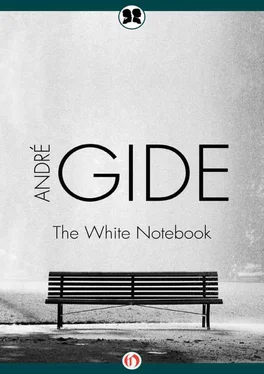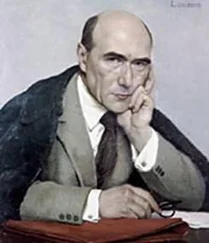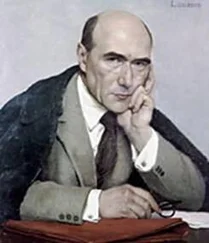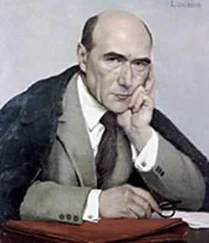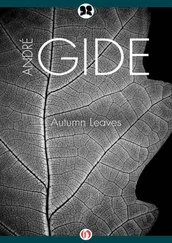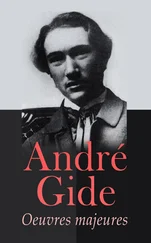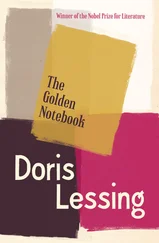27It is possible that this is the first allusion in any of Gide’s writings to his sexual aberrance.
28From earliest childhood the author evidenced a vivid imagination and a preference for dreams in contrast to reality. His answer to a question put to him in his old age might be cited to support theories he first formulated on the basis of Schopenhauer’s The World As Will and Idea. When asked whether Madeleine was the model for Alissa, he replied, “She became Alissa.”
29Noteworthy here is the characteristic link between sex and sin, attraction and repulsion with respect to the same object, and the practice of employing external surroundings as memory aids.
30His Journals reveal that Gide’s virtuous resolutions were made repeatedly only to be broken whenever his demons overpowered him. The Notebooks represent his first attempt to escape through his art from the clutches of his demons.
31Parts of the Notebooks were written while the author was in seclusion near the Grande Chartreuse. He viewed the monastery, considered visiting it as a tourist, decided against the visit.
32Gide seems here to anticipate his own paradoxical development, which prevented the consummation of his marriage even while permitting him to father an illegitimate daughter.
33Frequently in Gide’s writings we find an allusion to his concern for Madeleine, dating back presumably to his discovery of her mother’s infidelity and his intense longing at that time to protect her against the harshness of a counterfeit world.
34These same notions form the substructure of The Immoralist (1902).
35Ribot.
36The conflicts between faith and reason, appearance and reality, carnal passion and ideal love are familiar antinomies that motivate much of Gide’s art.
37The notion that in Madeleine he had found a kindred soul (an Echo for his Narcissus), persisted for years in Gide’s imagination despite indications to the contrary on her part
38Gide’s fraternal relation with his cousin Madeleine probably began at an early age. He was present at her father’s funeral in 1890, just as she had been present at the funeral of his father ten years earlier.
39Frequently and for many years Madeleine’s actions apparently belied Gide’s hopes.
40Madeleine, though frightened and insecure because of her childhood experiences, was older than Gide and had enough common sense to refrain from marrying him until after his mother’s death. It is doubtful that the two ever fully understood each other.
41Pierre Louis praised Gide for his choice of quotations, particularly this one from Baudelaire (and gave rise to the suspicion that he considered the quotations superior to the text).
42Paul Claudel once rebuked Gide for his fascination with mirrors. Gide completed his first book and simultaneously practiced the art of self-scrutiny by setting down his thoughts as he stood before a secretary equipped with a mirror.
43This section seems to recapitulate Gide’s adolescence and to anticipate his predicament after he had realized the full consequences of the complete separation of (carnal) pleasure and (ideal) love. His reaction to statues is recorded in his Journals, and his sensuousness and sensitivity to physical contact endured a lifetime and caused him alternately to tend toward renunciation and affirmation of the desire “to remain carnal unto death.”
44Gide was convinced that he had something to say to his generation, that his problem of formulating an austere ideal to free him from temptations of the flesh and protect him from anguish was a familiar problem, and that his time was limited. Though he had long nurtured the project, he was not able to begin writing systematically until the spring of 1890, when he, aged twenty, broke away from his mother for the first time and secluded himself at Menthon, near Grenoble. He felt that before the age of twenty-one he had to finish the work — and he did.
45Pierre Louis achieved fame (as Pierre Louys) before Gide and knew him during the period of the writing of the Notebooks but not during the year assigned to it in the While Notebook.
46In the Black Notebook (the Manichean twin of the White Notebook ) we learn that he does lose his mind but not before entrusting his notebooks to a friend for possible publication.
47The enigmatic conclusion may express doubt — conscious or unconscious — on the part of the author. In this section and others we find parallels to Manicheism, based on the doctrine of the two contending principles of good (spirit) and evil (the body).
48Soon after his arrival at Menthon, where he was writing the Notebooks, Gide installed a piano. Though he was an accomplished pianist, he is said to have played his best when no one was in the room and when he suspected that someone outside was listening.
49Highly significant in that it anticipates Gide’s conduct toward his wife after their marriage, this passage suggests both her role as the mother-sister image and the presentiment of his inability to consummate a physical union with Madeleine, “the only woman he ever loved.”
50Alissa, André Walter’s feminine counterpart in Strait Is the Gate, also practices humility and self-denial in pursuit of Christian glory; as in the case of all other Gidean heroines, she succeeds. She dies and Jerome finally possesses her, recalling again the Tristan legend and the tradition of fulfillment through denial.
51This entry strongly suggests that Gide blamed his mother for interfering with his plan to marry Madeleine and extricated himself from the painful situation by idealizing his love for both. Blinded by his own emotions, he was unable to appreciate the soundness of his mother’s advice to her niece or the perceptiveness of the latter in rejecting his proposal.
